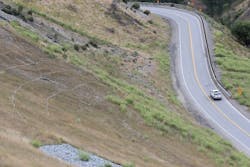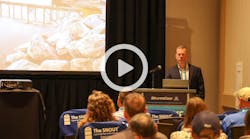Rain & Snow Melt Highway Solutions Win by a Landslide
Winner profiles were compiled by SWS Managing Editor Katie Johns and Associate Editor Cristina Tuser. Johns can be reached at [email protected] and Tuser can be reached at [email protected]
|
Location: Elmer City, Washington Cost: $2 million Size: 20 acres Owner: Okanogan County Manager: Okanogan County Public Works Designer: Josh Thompson of Okanogan County Contractors: Selland Construction, King Hydroseeding, ACF West, Profile Products Manufacturers: Bowie International |
In March 2017, a half-mile wide landslide caused by heavy rain and snow melt wiped out a portion of Peter Dan Road near Elmer City, Washington. More than 400,000 yards of material moved on the 650-foot long, 2.5H:1V slope, creating treacherous conditions. Okanogan County was forced to close the highway to all traffic while a solution was unearthed. With the roadway rebuilt, it was crucial that the slope was reinforced to prevent further devastation.
The contracting teams worked to conceptualize an alternative to trucking in compost and to ensure all products were properly installed. With a project of this size, the team faced several challenges, including soil conditions, landslide dangers, arid climate and worker safety.
The team chose to hydraulically apply ProGanics Biotic Soil Media across the site at 4,000 pounds per acre using hydroseeders to provide the organic matter and biological components needed to establish the vegetation the site required. The county wanted to ensure the additional risk of erosion was minimized while the vegetation was established. Considering the Grand Coulee Dam region in Washington sees an average of less than 11 inches of precipitation per year, it was important for the team to pick the proper plant species and amendments that could thrive year round. From installation in October 2018 to Notice of Termination in July 2019, only 9 inches of rain fell on the site.
“It was rewarding to see the relatively fast results from the installation of the ProGanics and amendments,” said Bill Black of King Hydroseeding. “This is not the case on most projects in this arid climate where results like this usually take three to five years if they occur at all."
The project required five people over the span of five days, with five pieces of equipment.


